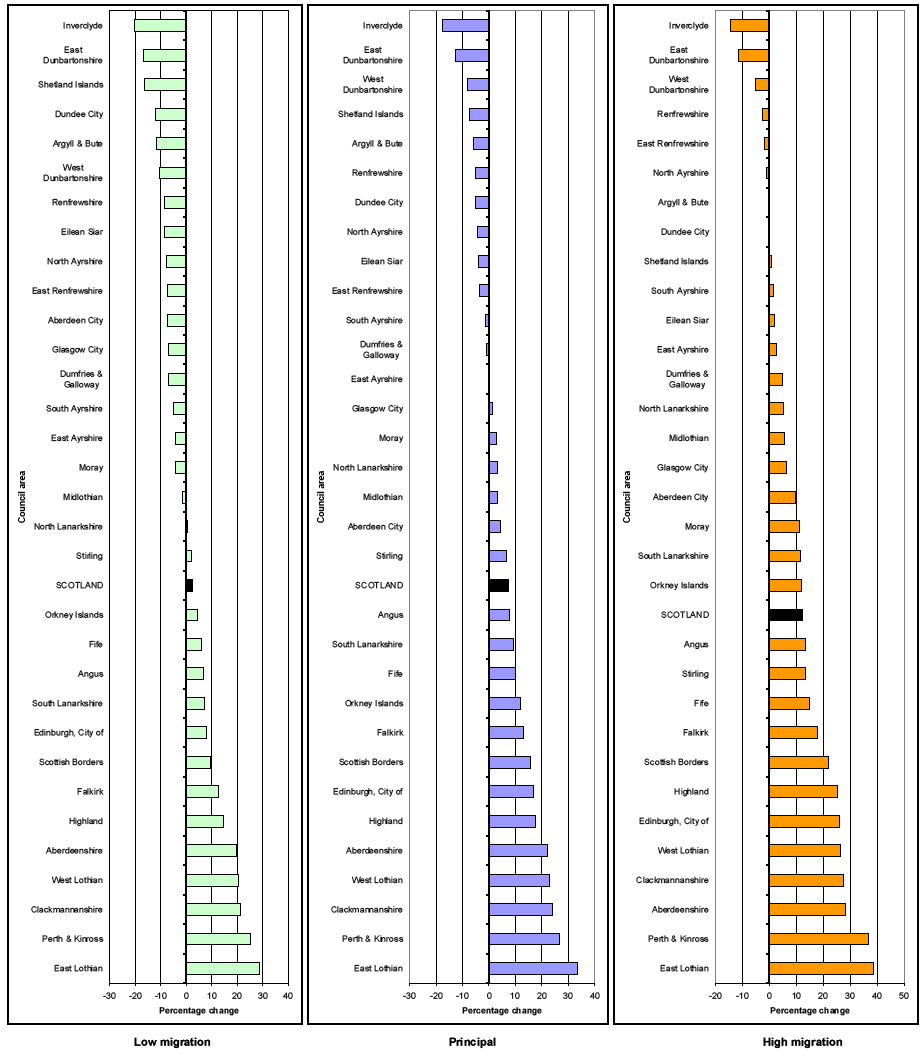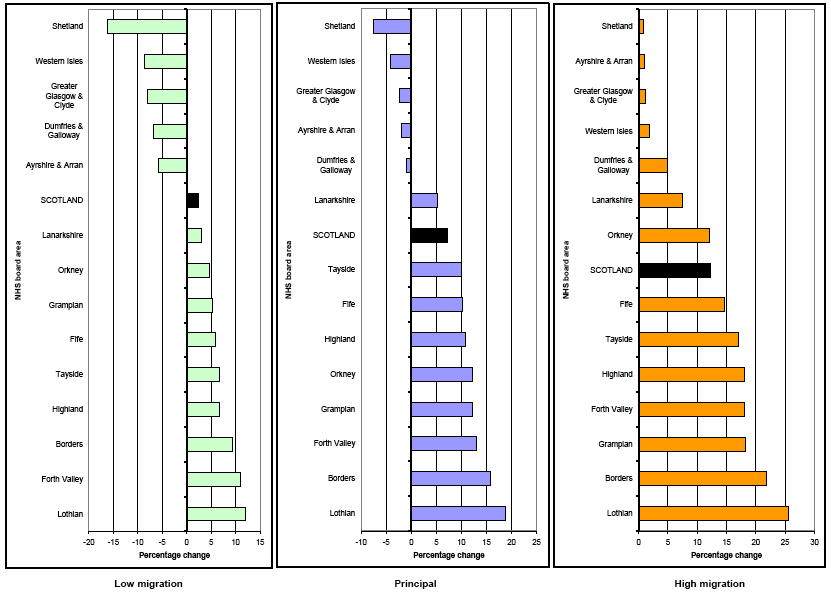
4.1. Most of this paper concentrates on the "principal" projection. This uses assumptions about fertility, mortality and migration which are thought to be most likely to occur over the next 25 years. A number of "variant" projections are produced at Scotland level and two of these, the high and low migration variants, have been produced for council and NHS board areas (the low migration variant for the first time). It should be noted that the high and low migration variants are not intended to provide upper or lower bounds, rather they use different plausible assumptions of what might happen in an area. These variant projections use the same fertility and mortality assumptions as the principal projection but assume higher or lower levels of net in-migration to Scotland. It should be noted that only moves to and from the rest of the UK and overseas are affected by this. The number of people moving between council and NHS board areas within Scotland does not change from the principal projection and so areas where the population is most affected by migration within Scotland will not change as much as those where international migration has the greater effect.
4.2 The high migration variant projection shows Scotland’s population rising from 5.17 million in 2008 to 5.80 million in 2033. This compares with an increase to 5.54 million in 2033 under the principal projection, and an increase to 5.29 million under the low migration variant. Table 6 shows the projected population for each council and NHS board area under the principal, high and low migration variant projections for selected years as well as the percentage difference between the different projections in 2033.
4.3 The chart at Figure 10a shows that the populations of 26 of the 32 council areas in Scotland are projected to increase and 6 to decrease by 2033 under the high migration variant, and that 15 of the 32 council areas increase and 17 decrease under the low migration variant. In general the largest increases and decreases occur in the same areas in both the low and high migration variants as they do under the principal projection but the size of the changes differ.
4.4 As in the principal projection, the council area projected to show the largest relative increase under the high migration variant over this period is East Lothian (+38 per cent). Perth & Kinross (+37 per cent) shows the second biggest increase under this projection and Aberdeenshire (+28 per cent), and Clackmannanshire (+28 per cent) also show large increases in population as they did under the principal projection. Again as in the principal projection, Inverclyde (-14 per cent) and East Dunbartonshire (-11 per cent) show the largest relative population decreases.
4.5 The populations of all the NHS board areas are projected to increase with the high migration variant, as can be seen in Figure 10b. As before, Lothian (+26 per cent), Borders (+22 per cent), Grampian (+18 per cent), and Forth Valley (+18 per cent) show the biggest increases.
4.6 Similarly under the low migration variant, the council area projected to show the largest relative increase over this period is East Lothian (+29 per cent). Perth & Kinross (+25 per cent) shows the second biggest increase under this projection and Clackmannanshire (+21 per cent) also shows a large increase in population as they did under the principal projection. Again as in the principal projection, Inverclyde (-20 per cent) and East Dunbartonshire (-17 per cent) show the largest relative population decreases.
4.7 The populations of 9 NHS board areas are projected to increase with the low migration variant, as can be seen in Figure 10b. As before Lothian (+12 per cent) shows the biggest increase, and Forth Valley (+11 per cent) and Borders (+9 per cent) also show large increases.
4.8 The third column from the end in Table 6 shows that the high migration variant projection has the biggest relative impact on Shetland (where the 2033 population is 9 per cent higher than under the principal projection). Edinburgh, Moray, and Perth & Kinross are all 8 per cent higher.
4.9 Table 6 also shows that the low migration variant projection has the biggest relative impact on Aberdeen City (where the 2033 population is 11 per cent lower than under the principal projection), Shetland (9 per cent lower), Edinburgh and Glasgow (both 8 per cent lower). As Figure 12 in Section 5.6 shows, these are all areas which gain migrants from outwith Scotland.
Figure 10a Projected percentage change in population under low migration, principal and high migration projections (2008-based), by council area, 2008-2033

Figure 10b Projected percentage change in population under low migration, principal and high migration projections (2008-based), by NHS board area, 2008-2033
